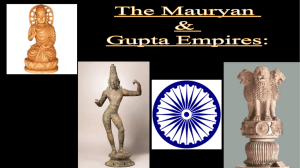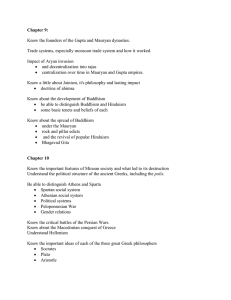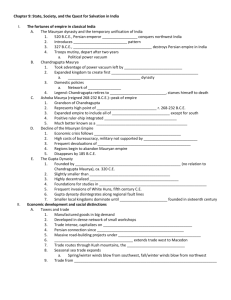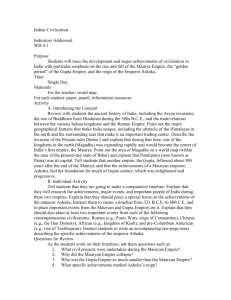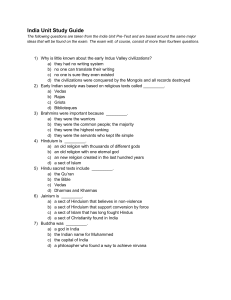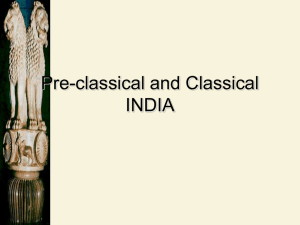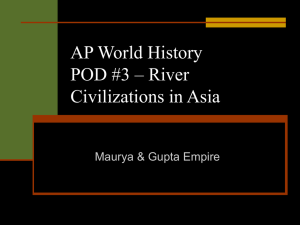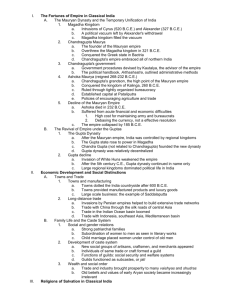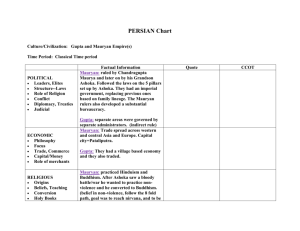Ch 3 Part IV - Mauryan and Gupta Empires
advertisement
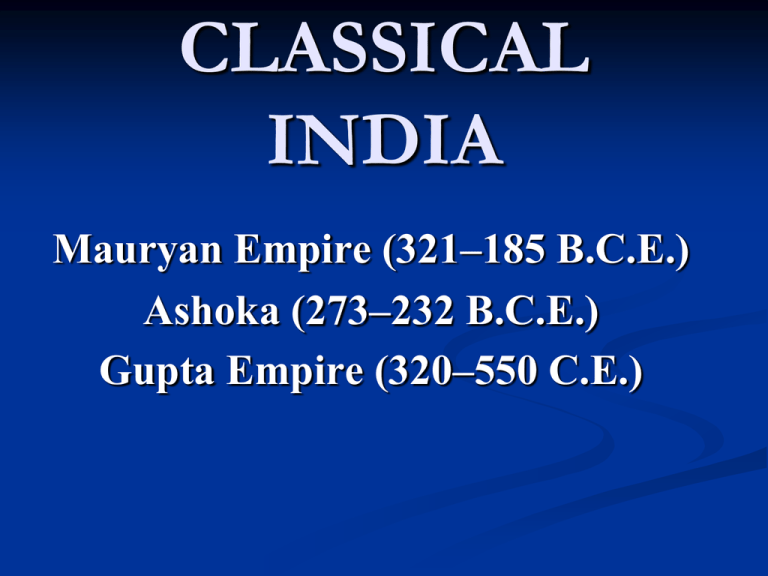
CLASSICAL INDIA Mauryan Empire (321–185 B.C.E.) Ashoka (273–232 B.C.E.) Gupta Empire (320–550 C.E.) III. Intermittent Empire: The Case of India A. The Aryan Controversy: After the decline of the Indus civilization, a wave of IndoEuropeans came into India. There is still much debate on the nature of their history. Did they invade suddenly? Peacefully and slowly migrate? Were they always there? B. Political fragmentation and cultural diversity, but a distinctive religious tradition: Despite the numerous small states and meager imperial tradition and despite the numerous languages and cultural traditions, there were several distinct and significant religious traditions that formed a common core that outsiders would come to call “Hinduism.” C. Mauryan Empire (321–185 B.C.E.): This first Indian empire may have been inspired by contact with Persia and the Hellenistic kingdoms. While impressive in size and power (50 million subjects and 600,000 infantry soldiers, 30,000 cavalry, 8,000 chariots, and 9,000 war elephants), this empire was not as long lived as Rome or Han. D. Ashoka (r. 273–232 B.C.E.): The most famous Indian emperor of the age was at first a great conqueror but later converted to Buddhism, adopting a moralistic tone and erecting numerous pillars and rocks carved with his edicts. E. Gupta Empire (320–550 C.E.): It was well over half a millennium before another state equaled the first empire. The Gupta Empire saw a flourishing of art, architecture, and literature, as well as commerce and the sciences. F. Great civilizational achievements without a central state: Despite a significant imperial tradition due to political fragmentation and conflict, South Asia was home to the growth of a significant long-distance trade network, major spiritual movements, and recorded impressive work in astronomy. RISE OF MAURYAN EMPIRE The “Golden Age” Ganges Republics Prior to Alexander, kshatriyan republics dominated, vied for power Magadha was one of the most dominant Western Intrusions Intrusions of Persians (520 B.C.E.) and Alexander (327 B.C.E.) Persians established Indus satrapy Alexander’s withdrawal left a political vacuum Magadha kingdom filled the vacuum Chandragupta Maurya The founder of the Mauryan empire overthrew the Magadha kingdom in 321 B.C.E. • Conquered the Greek state in Bactria, Selecuid control of Indus • Chandragupta's empire embraced all of northern India Chandragupta's government Government procedures devised by Kautalya, the advisor of the empire • The political handbook, Arthashastra, outlined administrative methods MAURYAN EMPIRE: ASHOKA Ashoka Maurya (reigned 273-232 B.C.E.) Chandragupta's grandson, The high point of the Mauryan empire Conquered the kingdom of Kalinga, 260 B.C.E. Ruled through tightly organized bureaucracy Established capital at Pataliputra Policies of encouraging agriculture and trade Converted to Buddhism Established a tolerant rule of righteousness Sent out missionaries to Sri Lanka, SE Asia, Central Asia Like other Ashokan pillars this is inscribed with accounts of Ashoka's political achievements and instructions to his subjects on proper behavior. These pillars are the earliest extant examples of Indian writing and a major historical source for the Mauryan period. The most famous Mauryan emperor is Ashoka ( 273–232 b.c.e.). Ashoka was shaken by the carnage in a brutal war of expansion in the south so he converted to Buddhism. His Buddhist policies of government are preserved in edicts that were inscribed on rocks and pillars at various points throughout his empire. (Pg 153-154 – The Rock Edicts) Decline of the Mauryan Empire Ashoka died in 232 B.C.E. Suffered from acute financial and economic difficulties High cost for maintaining army and bureaucrats Debasing the currency, not an effective resolution The empire collapsed by 185 B.C.E. THE GUPTAS 320 – 550 C.E. The Gupta Dynasty After Mauryans, India was controlled by regional kingdoms The Gupta state rose to power in Magadha Chandra Gupta founded the new dynasty Gupta dynasty was relatively decentralized Officially supported revival of Hinduism as state faith Era seen as the Golden Age of Hinduism Like the Mauryan rulers, the Guptas controlled iron deposits, established state monopolies, and collected a 25 percent agricultural tax. However, they were never as strong as the Mauryan Empire. Gupta Government Power The Guptas used their army to control the core of their empire, but provincial administration was left to governors who often made their posts into hereditary and subordinate kingdoms and kinship groups. The Gupta Empire had a king that was the center of the administration. The different groups were divided into several provinces and each were sub-divided into several series of districs. The villiages were organized under rural bodies and consisted of the headman and villiage elders. In the cities, there was a council that had several offices like the president of city corperation and chief representative of guild merchants. - The Gupta Empire had a Monarchy government. Gupta Decline Because the Gupta did not have sufficient military force, they exercised power as a “theater-state,” redistributing profits and luxury goods from trade and dazzling its dependents with elaborate ceremonies in return for gifts and other favors. Invasion of White Huns weakened the empire After 5th century C.E., Gupta dynasty ruled in name only Lack of Gupta Evidence We have very little archaeological data and few contemporary accounts from which to learn about the politics, society, and culture of the Gupta period. We know that the court supported mathematics and astronomy and that Gupta mathematicians invented our “Arabic” numerals and the concept of “zero.” We also have the Chinese monk Faxian’s description of his journey through Gupta India. Gupta Religion The Gupta period, while dominated by Hinduism, was characterized by religious toleration and saw the development of the classic form of Hindu temples with exterior courtyard, inner shrine, and wall decorations. Gupta Decline During the Gupta period, women lost the right to inherit and own property and to participate in key rituals, and were treated like the lowest varna (Shudra). They were married very young, and in some places a widow was required to burn herself on her husband’s funeral pyre. Among the few ways to escape this low status was to join a religious community, to be a member of an extremely wealthy family, or to be a courtesan. ECONOMICS In 550 c.e the Gupta empire collapsed under the financial burden of defense against the Huns. Harsha (r. 606–647 c.e), whose kingdom is described by the Chinese pilgrim Xuanzang, briefly reunited northern India. After Harsha, northern India again fell into political fragmentation. ECONOMICS Gupta India was linked to the outside world by extensive trade networks. Trade with southeast and east Asia was particularly flourishing. Towns and manufacturing Towns dotted the India countryside after 600 B.C.E. Towns provided manufactured products and luxury goods Long-distance trade Invasions by Persian empires helped to build extensive trade networks Trade with China through the silk roads of central Asia Trade in the Indian Ocean basin, Indonesia, Southeast Asia, Mediterranean basin Spread Buddhism and Hinduism throughout Indian Ocean basin SOCIETY Social and gender relations Strong patriarchal families; subordination of women to men Child marriage placed women under control of old men Development of caste system Brahmins, Kshatriyas, Vaishyas, Shudras (part of Hinduism) New social groups of artisans, craftsmen, and merchants appeared Individuals of same trade or craft formed a guild; guilds were subcastes, jatis Functions of guilds: social security and welfare systems Wealth and social order Trade and industry brought prosperity to many vaishyas and shudras Old beliefs and values of early Aryan society became increasingly irrelevant Caste System of both Empires IV. Reflections: Enduring Legacies of Second-Wave Empires A. Mao Zedong and Qin Shihuangdi: Leader of Communist China in the twentieth century idealized the first emperor’s brutal path to state building as a revolutionary triumph for progress. B. Ashoka in modern India: Seeking to promote an image of a peaceful and tolerant India, the leaders of the new nation adopted symbols of Ashoka’s reign in 1947. C. British imperial and Italian fascist uses of Rome: Both the British colonial empire and Mussolini’s Italy used the Roman Empire as a crucial precedent for rationalizing their rule.
